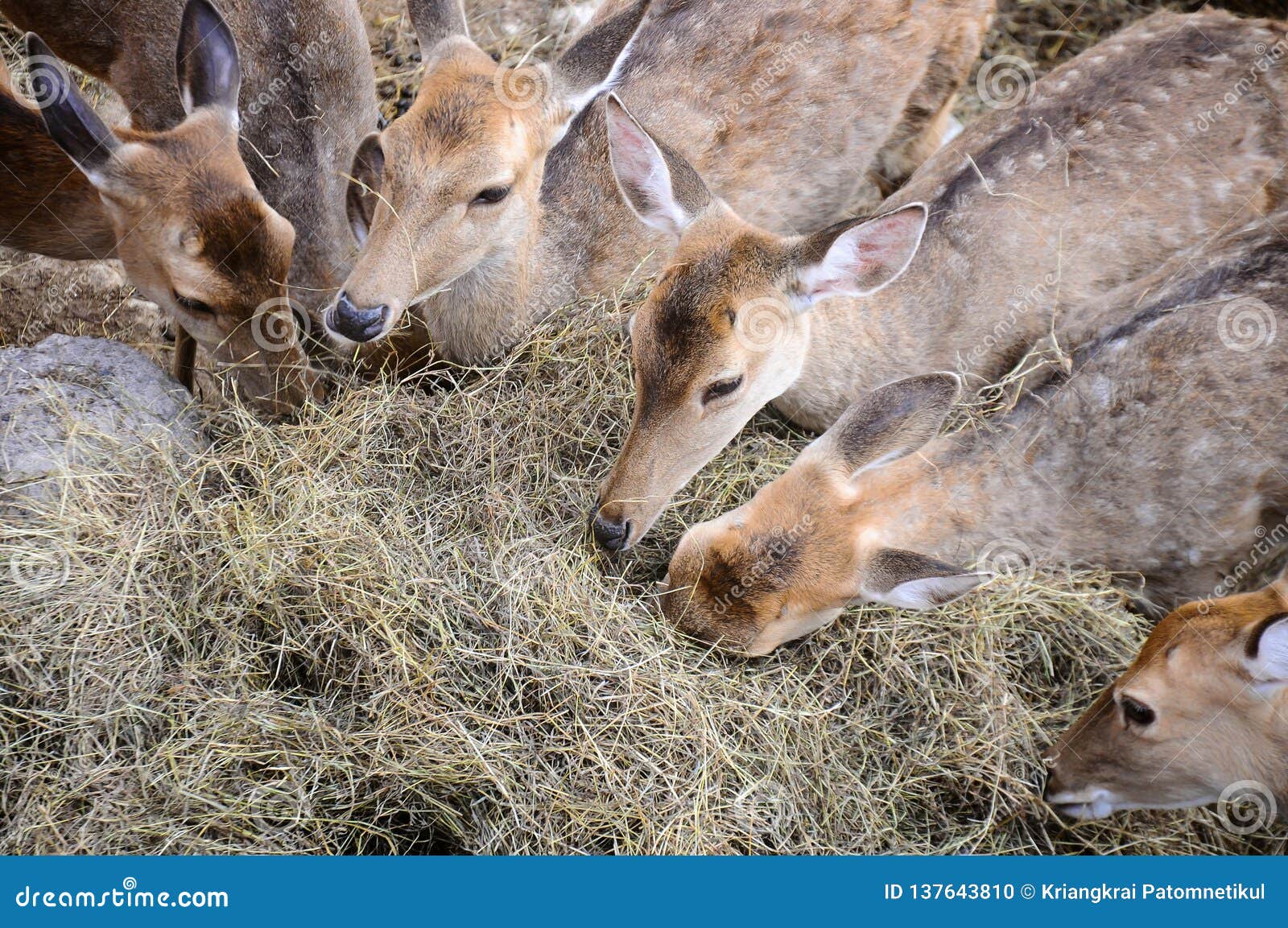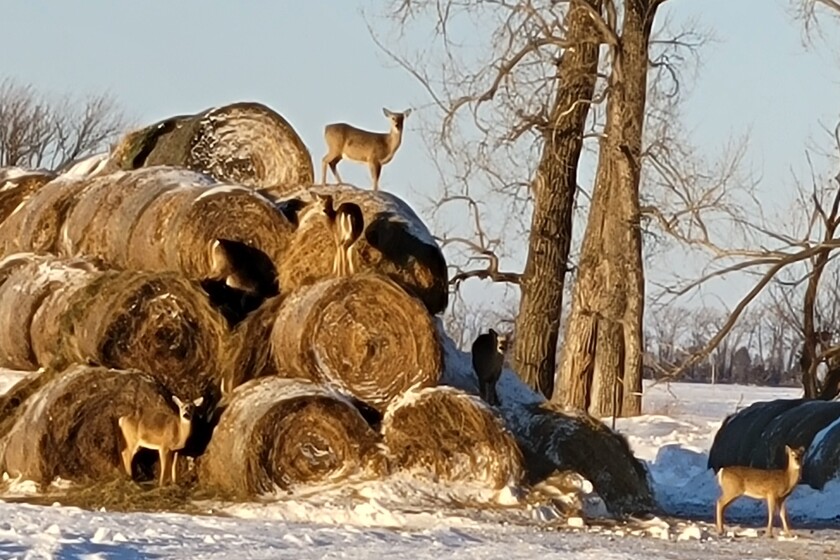Yes, deer will eat hay. They may not prefer it over other food, but they will consume it when necessary.
Deer are often seen grazing on natural foliage, but during winter or food shortages, hay can be a viable option for them. Deer are browsers and their diet typically includes leaves, twigs, and grass. When natural food is scarce, they turn to alternative sources.
Hay, although not their first choice, provides essential nutrients and helps them survive tough conditions. Understanding what deer eat can help in managing wildlife and ensuring their well-being, especially in areas where their natural habitat is affected. So, while hay isn’t their favorite, it definitely plays a role in their diet during challenging times.
Deer’s Natural Diet
Deer are fascinating creatures with a varied diet. They are herbivores, relying on a range of plants for nourishment. Understanding their natural diet can help us know what they prefer to eat.
Plants And Leaves
Deer primarily eat plants and leaves. They graze on grass, shrubs, and young trees. This is their main source of food.
In the spring and summer, they prefer tender green leaves and shoots. These parts are rich in nutrients. During fall and winter, they shift to twigs and bark. This is because fresh growth is scarce.
Fruits And Nuts
Deer also enjoy fruits and nuts. They are a treat for them. In the fall, they seek out acorns, chestnuts, and beechnuts. These nuts provide high energy. It helps them prepare for the winter.
Fruits like apples, berries, and persimmons are also favorites. They offer a sweet and nutritious snack. Deer will often visit orchards and gardens to find these treats.
Seasonal Dietary Changes
Deer are highly adaptable creatures. Their diet changes with the seasons. Understanding these changes helps in providing the right food. Deer have different needs in summer and winter. Let’s explore their seasonal dietary changes.
Summer Feeding Habits
In summer, deer have plenty of food choices. They prefer fresh, green vegetation. Their diet includes:
- Grass
- Leaves
- Fruits
- Young shoots
Deer also enjoy garden plants and crops. They often feed on vegetables, flowers, and fruits. Their diet is rich in water and nutrients during summer. This helps them stay healthy and strong.
Winter Survival Foods
Winter is a challenging time for deer. Food becomes scarce. They must adapt to survive. In winter, deer often eat:
- Woody plants
- Bark
- Twigs
- Hay
Hay becomes an important food source for deer in winter. It provides necessary nutrients when other food is limited. Deer may also eat acorns and leftover crops. Their diet is lower in water but still provides energy.
| Season | Food Sources |
|---|---|
| Summer | Grass, Leaves, Fruits, Young Shoots, Garden Plants |
| Winter | Woody Plants, Bark, Twigs, Hay, Acorns, Leftover Crops |
Hay As A Food Source
Hay can be a viable food source for deer, especially during winter. It provides essential nutrients and can help sustain deer populations when natural forage is scarce. Understanding the nutritional value and types of hay is crucial for anyone considering feeding hay to deer.
Nutritional Value Of Hay
Hay offers a range of nutrients that are beneficial for deer. It contains fiber, which aids in digestion. It also provides protein, which is essential for growth and maintenance. Some hays are rich in vitamins and minerals. These nutrients help keep deer healthy and active.
Types Of Hay
There are several types of hay that deer can eat. Alfalfa hay is one option. It is high in protein and nutrients. Another type is Timothy hay. It is lower in protein but still beneficial. Orchard grass hay is also a good choice. It is palatable and nutritious.
Choosing the right type of hay depends on the deer’s needs. Younger deer may benefit more from high-protein hay. Older deer may prefer grass hay. Always ensure the hay is fresh and free from mold. Moldy hay can be harmful to deer.

Credit: www.dreamstime.com
Deer’s Preference For Hay
Deer are fascinating creatures with diverse diets. Many wonder if deer prefer hay. While deer will eat hay, their preference depends on various factors. Let’s explore what influences a deer’s choice to eat hay.
Factors Influencing Preference
The availability of natural foods greatly impacts a deer’s preference for hay. During winter, natural food sources are scarce. Hay becomes a crucial food source. The quality of hay also matters. Fresh, leafy hay is more appealing. Moldy or dusty hay often gets ignored. Deer also consider the nutritional content. High-protein hay attracts more deer. Lastly, the presence of other food options influences preference. If there are better choices, deer might ignore hay.
Comparing Hay To Natural Foods
Natural foods are usually more nutritious than hay. Acorns, berries, and twigs offer more variety. These foods meet the deer’s dietary needs better. Hay is a good alternative, though. It provides necessary fiber and energy. In harsh winters, hay can be a lifesaver. It fills the gap when natural foods are unavailable. Deer may not prefer hay, but they appreciate its availability during tough times.
Potential Benefits Of Hay
Feeding hay to deer can provide several advantages. These benefits can be crucial, especially during certain seasons or unexpected situations. The following sections discuss the potential benefits of hay for deer.
Supplementing Winter Diet
Deer struggle to find food in winter. Snow covers their usual food sources. Hay can supplement their diet during these tough months. It provides the necessary nutrients. This keeps deer healthy and strong until spring.
Emergency Food Supply
Natural disasters or habitat loss can disrupt a deer’s food supply. In such cases, hay serves as an emergency food source. It ensures that deer do not starve. Hay can be stored and used when other food is not available. This can be a life-saving measure for wild deer populations.
Risks Of Feeding Hay
Feeding hay to deer might seem like a kind gesture. But it can pose certain risks. These risks can affect the deer’s health and behavior. Let’s explore some of these potential problems.
Digestive Issues
Deer’s stomachs are built for natural forage. Hay is not a natural part of their diet. Eating hay can disrupt their digestion. This disruption can lead to bloating and discomfort.
In severe cases, eating hay can cause a blockage. A blocked stomach can be life-threatening. Deer need a diet rich in natural plants. Hay lacks many of the nutrients they need.
Dependency Concerns
Feeding hay can create dependency. Deer may start relying on humans for food. This reliance can make them less able to find natural food.
Deer that depend on humans may face starvation. They might not learn to forage on their own. This can be especially dangerous in the wild.
Relying on hay can also reduce their natural survival skills. They may become less wary of predators. This could increase their risk of being hunted.
Best Practices For Offering Hay
Offering hay to deer can be a thoughtful way to provide them with extra nourishment, especially during colder months when other food sources are scarce. However, to ensure the deer benefit from the hay, there are some best practices to follow.
Proper Presentation
Place the hay in a dry, elevated spot. This keeps it clean. Wet hay can mold, making it unsafe. Use a hay feeder or platform. Scatter some hay around to attract them. Avoid placing hay near roads or busy areas. Safety is essential.
Combining With Other Foods
Hay alone might not meet all their needs. Mix in other natural foods. Add some apples, acorns, or leafy branches. This variety helps maintain a balanced diet. It also makes the feeding spot more appealing. Rotate the food mix to keep it interesting. Observe what they prefer and adjust.

Credit: www.agweek.com
Alternative Food Sources
Deer often need alternative food sources, especially during the winter months. Hay is a common choice, but there are other options that can be more nutritious and appealing to deer. Let’s explore some of these alternatives.
Commercial Deer Feed
Commercial deer feed is specially formulated to meet a deer’s nutritional needs. These feeds contain essential vitamins and minerals. They often include grains, corn, and protein sources. This can help deer stay healthy and strong. They are available at most agricultural stores.
Natural Foraging Options
Deer naturally forage for food in the wild. They eat a variety of plants, leaves, and twigs. Acorns and nuts are also favorites. These provide essential nutrients. Deer will also browse on shrubs and bushes. This keeps their diet diverse and balanced.

Credit: www.wildlifeonline.me.uk
Frequently Asked Questions
Do Deer Eat Hay In Winter?
Yes, deer eat hay in winter when food is scarce. It provides essential nutrition.
Is Hay Safe For Deer To Eat?
Yes, hay is safe for deer. It offers a good source of fiber and energy.
What Type Of Hay Do Deer Prefer?
Deer prefer alfalfa hay. It is rich in protein and nutrients, making it beneficial for their diet.
Can Feeding Hay Harm Deer?
Feeding hay in moderation is safe. Overfeeding can cause digestive problems. Balance it with natural foods.
Why Do Deer Eat Hay?
Deer eat hay when natural food sources are limited. It helps them survive harsh conditions.
Conclusion
Deer can eat hay, but it’s not their favorite food. They prefer natural forage like leaves and twigs. Offering hay can help in harsh winters. Make sure it’s good quality hay. Watch for signs of deer accepting or rejecting it.
Always consider the nutritional needs of deer in your area. Balancing their diet supports their health. Now you know more about feeding deer. Thank you for reading!